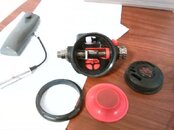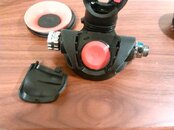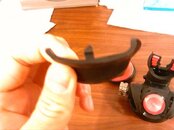I think we have lost the lessons of the past. When the single hose regulators first came out, a folded over exhaust valve was a possibility in the U.S. Divers Company Calypso (original), on some of the Healthways very early second stages, and on several other models. Cave divers complained that they would leak when in a current in certain orientations, and the manufacturers responded with more protected exhaust valves, either in a recess (third generation Calypso, Dacor Dart and Olympic, AMF Voit MR-12, etc.), or with double exhalation valves (Healthways, dry regulator but these caused higher exhalation resistance).
Now, we have other demands on the second stages. They must be light, because the divers paying big bucks for regulators are travel divers, and these regulators are minimalist. Looking at the D1 second stage, it is apparent that these lessons from the past have been lost, and that a severe current from the side (from water currents in a river, or from an entry) can and do displace the mushroom valve, and in this case actually folded it over to cause an incident. Because of great dive planning, it did not have a severe consequence. But it could have, as is documented in Bernie Chowdhury's book,
The Last Dive. In the chapter of the same name, there is this passage pertaining to Chris and Chrissy Rouse's 230 foot dive:
As they slowly ascended, they would have automatically checked their pressure and depth gauges, and then their forearm-mounted diving computers. Chrissy later said that the computers indicated they had been underwater for forty minutes...
...Chrissy now switched tothe scuba bottle that his father had clipped to him after they escaped the wreck. But instead of breathing air, only water came through the mouthpiece. Postdive analysis revealed a torn mouthpiece that would have allowed water to enter.
What happened next is another matter for conjecture; two diferent scenarios wer reported by the divers on the scene. Some believe that Chrissy tried repeatedly to purge the regulator so that he could get air instead of water through the unit. Each time he pressed the purge button it would have released a large quantity of air from the tank. The postdive analysis of this tank revealed a 60 percent oxygen mixture and the tank slightly less than half full. If Chrissy had started out with this extry tank at full capacity, then the half-ful tank can be explained by Chriss's repeatedly trying to purge the regulator of water. According to this theory, Chrissy headed for the surface after trying unsuccessfuly several times to get breathing gas from his regulator, and his father followed him...
(page 275-276, paperback edition.)
This incident for this thread could have ended much differently in the OpEd had not dived a great plan with backup air available. I don't do decompression dives--too old for that now, and my feelings are that if people purposely dive decompression dives, they should have a recompression chamber immediately available or have med-evac plans made up to get to a chamber ASAP.
The attempts to use the regulator purge valve, if it actually happened (there was some doubt in the book) were unsuccessful; this is a skill that would need to be practiced to be successful.
But there is one other alternative that nobody has mentioned. We have been well trained, perhaps too well trained, that we never get the first stage chamber wet. Yet, if you go back to the 1960s and watch Cousteau's
World Without Sun (available on You Tube) you will see the Deep Cabin divers making a dive to over 300 feet, and other divers bringing them extra gas cylinders via scooter. There is a sequence of these divers taking those cylinders, doffing their own rig,
and changing their Mistral single stage, double hose regulators underwater to put them onto the full tanks. Although it will screw up a modern regulator eventually, I believe this is possible with today's single hose regulators. Has anyone validated this idea?
SeaRat







